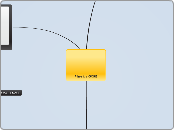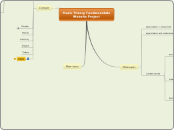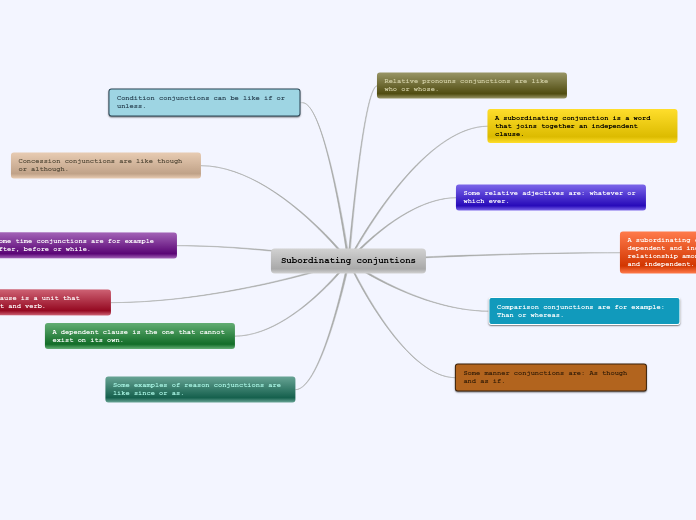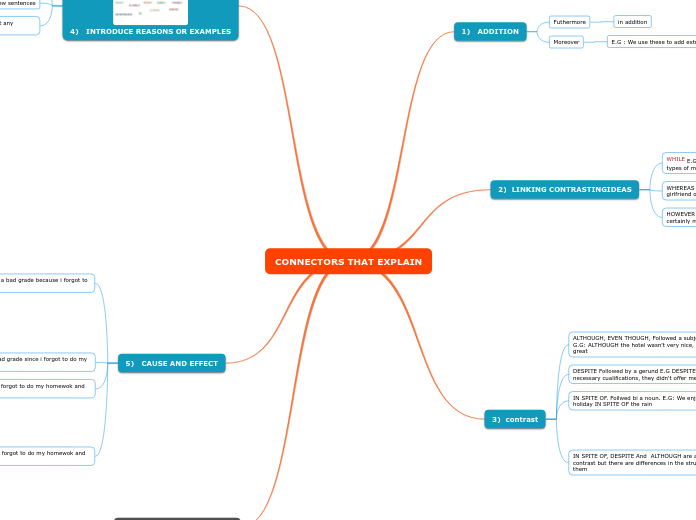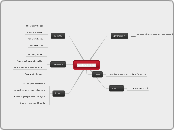Newton's Laws
Newton's Second Law
= maAlso known as Newton's Second Law - you will have seen this equation during your course. F is the force in Newtons, N. m is the mass in kilograms, kg. a is the acceleration in m/s2.This shows that if you keep the mass constant and double the applied force the acceleration will double. If you plot a graph of force against acceleration it will look like this:You can see here that force is proportional to acceleration. As you double the force the acceleration doubles, as you triple the force the acceleration triples.If you plot a graph of acceleration against mass it will look like this:You can see here that if you keep the force constant and increase the mass the acceleration will fall. Acceleration is inversely proportional to mass. If you double the mass the acceleration will halve. It is helpful if you can rearrange this equation. The triangle for this is as follows:Some examples: 1. A 500kg car accelerates at 3 m/s2. How much force is exerted by the wheels to accelerate the car? Answer: Write down the formula: F = ma Plug in the numbers: F = 500 x 3 Write down the answer: F=1500NNote: Don't forget the units! 2. A 500kg car is accelerated by a force of 2000N. What is its acceleration? Answer: Important point: The equation works in exactly the same way for deceleration as it does for acceleration!
Newton's First Law
Every body continues in a state of rest or uniform motion unless acted upon by an external force.' This sounds really complicated... but isn't. Imagine that you are playing table hockey. If you have not put your money in and you give the puck a hit, it doesn't travel very far. Friction stops it. However, if you put your money in, air is pumped out of the holes in the table and so when you give the puck a flick, it will travel to the other end of the table. There is much less friction to slow the puck down. You need the end of the table to stop it. In both cases, a force starts and stops the puck, but a force is not needed to keep it moving at a steady speed. So in other words, something without a net force acting on it will either stay still or move at a constant speed in a straight line until you apply a force to it. When you apply a force to it, it will either: Speed up, Slow down, Change direction, (Or change shape).
Physics GCSE
Pressure
Net forces
at do we mean by a 'net' force? Well, forces do not add up like normal numbers - you must take their direction into account as well. For example, if you were teetering on the edge of a cliff and someone applied a force to you, you would probably like the force applied in a certain direction.It is easy to add up forces, just look at these three examples:
What can forces do?
rce can do one of four things to an object: 1. Make it speed up - accelerate. 2. Make it slow down - decelerate. 3. Change its direction. 4. Change its shape. If something is doing one of these four things there must be a net force acting upon it.
Moments
oment = Force x Distance Force is measured in newtons, N. Distance is measured in either m or cm. If the distance is in m then the moment will be measured in Nm. If the distance is in cm then the moment will be measured in Ncm.(Note: The force needs to be at right angles to the lever or rotating object.) In many situations there is more than one moment acting. To find the net or resultant moment the moments have to be added or subtracted, depending on their direction. Here is a worked example: Moment due to A = 20 x 2 = 40 Nm anti-clockwise Moment due to B = 10 x 1 = 10 Nm anti-clockwiseMoment due to C = 20 x 3 = 60 Nm clockwise The total anticlockwise moment is 40 +10 = 50 Nm. The total clockwise moment is 60 Nm. So the resultant moment is 60 Nm - 50 Nm = 10 Nm clockwise. Now here is one for you to try. Fill the correct numbers into the boxes:
Forces
Forces and Pressure
In Gases
n gasesAlthough gases are compressible (squashy) they exert a pressure because of the gas particles bouncing off things. The pressure the air exerts at the surface of the Earth is about 100,000 Pa. Luckily, our bodies have evolved to cope with that pressure, or we would be squashed. The diagram below illustrates how gas particles exert more pressure when the gas is squashed. Both cylinders have the same number of particles in - and both sets of particles are going the same speed. Notice that the particles in the small cylinder hit the walls more frequently - because there is less distance for the particles to cross from the top to the bottom of the cylinder. Now remember that it is the collisions that cause the pressure - more collisions means more pressure. So the fact that there are more collisions in the small container means that the pressure is higher in the small container. Boyle's LawThe diagram above explains why changing the volume of a gas sample changes the pressure of the gas. Boyle's Law is a way of calculating how much the pressure changes when the volume changes. An eighteenth century scientist called Robert Boyle discovered that for a fixed mass of gas the pressure x the volume of the gas stays the same. In other words, as you squeeze a gas its pressure will go up and its volume will get less. Important point: The temperature and mass of gas must stay the same for this to be true! We can write this as: pressure x volume = constant or P1V1 = P2V2 where: P1 is the pressure of the gas at the start, V1 the volume of the gas at the start and P2 and V2 the pressure and volume of the gas at the end. This tells us if we double the pressure of a gas its volume will halve. If we reduce the pressure by one half, the volume will double.Example: Imagine a balloon full of air. The air's pressure is 10N/cm2 and its volume is 300cm3. You squash the balloon to 200cm3 without any air escaping. What is the pressure of the air inside the balloon? Answer: Write down the formula: P1V1 = P2V2 (Remember: P1 is the pressure at the start, V1 is the volume at the start, etc) Plug in the numbers: 10 x 300 = P2 x 200Rearrange the equation to give: so P2 = 15 N/cm2. Remember: The temperature and mass of gas must remain the same for this to work!
In Liquids
n liquidsWhen it comes to pressure in liquids, there are 3 rules that you need to remember: 1. Pressure increases with depth Have you ever noticed that when you dive down to the bottom of a swimming pool, your ears start to hurt? The further you dive down, the more it hurts. This is because the pressure in a liquid increases as you go further below the surface of the liquid. A common example in exams is this - a can full of water with holes down the sides. Notice how the further down the hole is, the faster the water comes out because the higher the pressure is in that part of the can. Here are some other common examples. Can you explain them? Water comes out of a downstairs tap faster than an upstairs tap. Dam walls have to be thicker at the bottom than at the top. You always get these ideas in any movie that has a submarine in it. You can guarantee that at some stage during the film, the sub will go too deep! Alarms will sound, people start to sweat, look nervous and the sub will creek and groan. Sometimes, the water will burst in and the sub will 'implode' (that means explode inwards rather than outwards). This is due to the fact that the pressure from the water outside the submarine increases as the sub goes deeper and deeper until the structure of the sub isn't strong enough to resist - and it is crushed. 2. Pressure acts equally in all directions To illustrate this: Grab a plastic bag. Fill it with water. Tie a knot in the top. Squeeze it. Then poke holes in the bag with a pin! Water goes everywhere! And that's the point. Water, from holes at the top of the bag, goes up. Water, from holes at the side of the bag, goes sideways. Water, from holes at the bottom of the bag, goes down.This shows that the pressure in the water (which makes the water squirt out of the bag) is acting in all directions - not just downwards! There's another example that helps to explain this. Remember when you are swimming at the bottom of the pool and your ears are hurting. It doesn't matter what you do with your head - turn left, right, twist it up or down - your ears hurt just as much. The water is pushing in on them from all sides equally - not just downwards. 3. Pressure is transmitted through liquids You can't squash liquids. We say that they are 'incompressible'. Fill a syringe with water. Put your thumb over the nozzle and press the plunger. It won't move. The water in the syringe can't be compressed. Do the same thing with a syringe full of air and you can easily squash it. Air is compressible. The fact that you can't compress liquids is extremely useful. It means that pressure can be transmitted through liquids. An example - you connect two syringes together with a pipe and then fill them with water. Press one plunger in - and the other one comes out. That's because you have transmitted pressure from one plunger to the other. This is used in hydraulics. Hydraulics All hydraulics systems work because the pressure is the same throughout the system. A really good example of this is a car brake system. You need to know all about this for your exams. Think about it. If you are driving a car along a motorway, you can stop it quite quickly by pushing gently on the brake pedal. Now here's an alternative. You are driving a car along a motorway and you decide to stop. So you open the door, and, using the same force as above, gently press down on the tarmac with your foot. (P.S: In case you need to be told - don't try this!!!) You won't be surprised to learn that the car doesn't stop nearly as quickly. And, you wreck your trainers! So how does the car turn the small force that you apply to the brake pedal into the huge force needed to stop a speeding car?If you look at the above diagram, you can see that the brake cylinder by the pedal (the master cylinder) that the driver presses is very narrow. But the cylinders by the brakes (the slave cylinders) are very wide. This means they apply a much larger force. Why? Because the pressure in the liquid is the same everywhere. So if the area is bigger in the slave cylinders the applied force must be bigger too. This is easier to see with an example. If you push the master cylinder with a force of 12N and it has an area of 3cm2. Using the equation: This means the pressure in the master cylinder must be: Now, because pressure is the same throughout the system, that means that the pressure in the slave pistons must also be 4N/cm2. If the slave cylinders have an area of 12cm2, using the equation: Force = Pressure x area Force = 4 x 12 Force = 48N(Note: The pressure stayed the same.)
In Solids
n solidsThink about these two situations: Pushing a drawing pin into a wall pointy end towards the wall. Pushing a drawing pin into a wall pointy end towards your thumb. Two similar activities with two very different results. The reason for this is the difference in pressure. Assuming the same force is applied, each case would have a different pressure acting on the thumb. In the first diagram the thumb pushes on a large area so the force is spread out and the pressure is low. In the second diagram the force is concentrated on a small area so the pressure is much higher. If a force is applied over a smaller surface area you get a larger pressure. Pressure can be calculated using the following equation: Force will be in newtons, N. Area will be in either m2 or cm2. If the area is in m2 then the pressure will be measured in Pascals or N/m2. If the area is in cm2 then the pressure will be in N/cm2.Example: A lump of cheese of weight 20N stands on a table. It is a cubic lump with an area of 10cm2. What pressure does it exert on the table? Answer: Note: Don't forget the units!
